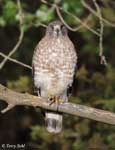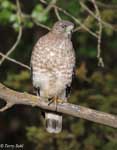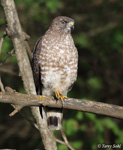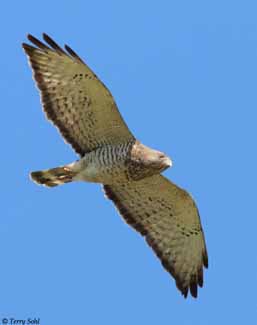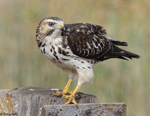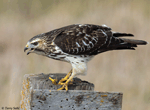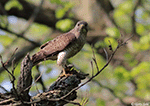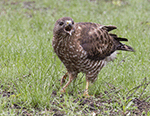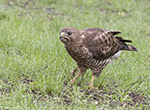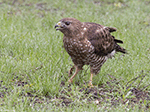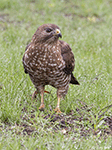| Length: 13 - 18 inches | Wingspan: 32 - 38 inches | Seasonality: Migrant / Summer |
| ID Keys: Broad bands on tail, dark brown upperparts, reddish barred underparts | ||
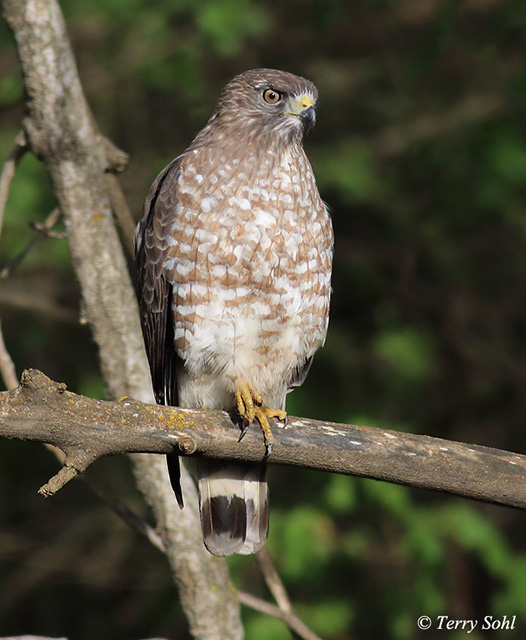 The Broad-winged Hawk is
the smallest of the North American Buteo hawk species. They are generally
found near forest edges and clearings, where they can be seen perched on a
branch as they scope the ground below for potential prey. During migration, thousands may congregate
along ridgelines and coastlines or other locations with favorable wind
conditions. Relatively tame, Broad-winged Hawks can often be approached more
closely than most hawks.
The Broad-winged Hawk is
the smallest of the North American Buteo hawk species. They are generally
found near forest edges and clearings, where they can be seen perched on a
branch as they scope the ground below for potential prey. During migration, thousands may congregate
along ridgelines and coastlines or other locations with favorable wind
conditions. Relatively tame, Broad-winged Hawks can often be approached more
closely than most hawks.
In South Dakota, Broad-winged Hawks are most often seen as migrants. In spring, that may often be as individual birds, but very large kettles of migrating Broad-winged Hawks can sometimes be seen in autumn. Small numbers do breed in the far eastern part of the state, primarily in the riparian and nearby forests along river systems.
Habitat:
Breeds in deciduous or mixed forest, generally near clearings. Prefers locations near water. During migration, they may be found in nearly any habitat, but generally roost in forest at night.
Diet:
Will feed on a wide variety of items, including small mammals, frogs, snakes, lizards, small birds, large insects, and earthworms.
Behavior:
Broad-tailed Hawks usually hunt from a perch, often along forest and woodland edges and near water. During courtship, pairs may be seen circling high in the sky together, calling to each other, and then plummeting towards the ground together.
Nesting:
May through July. Broad-winged Hawks nest in either deciduous or mixed forests, and will build their nests in either deciduous or conifer trees. Most commonly, the nest is placed next to the trunk on a horizontal branch, in the lower part of a tall tree. A nest platform built of sticks and twigs is first constructed, and then a bowl is constructed within that, lined with bits of bark and other vegetative material, occasionally with other material such as feathers, roots, or mosses. The female lays between 2 and 5 eggs, and both parents help to incubate the eggs. Incubation lasts about 30 days, with the young fledging from the nest 5 to 6 weeks after hatching.
Song:
The call of a Broad-winged Hawk is a thin, high-pitched whistle with a short first note followed by a much longer second note of the same tone.
- Click here to hear the typical call of a Broad-winged Hawk1
- Click here to hear the calls of two perched birds2
Migration:
Summers throughout most of the eastern United States, and southeastern and south-central Canada. Long distance migrants, most Broad-winged Hawks fly to South America for the winter. They sometimes form huge "kettles" in migration that may consist of many thousands of birds.
Interactive eBird Map:
Click to access an interactive eBird map of Broad-winged Hawk sightings
Similar Species:
Broad-winged Hawks could be confused with their "Buteo" Hawk cousins, given the similar overall structure, or perhaps confused with the "Accipiter" Hawk species given the plumage pattern and size. Click here for a page that describes differences between the "Buteo" hawk species, and identification keys for each. Otherwise, here are keys for differentiating Broad-winged Hawks from some of the most similar species:
-
Red-shouldered Hawk -Another compact Buteo hawk, Red-shouldered
Hawks are typically just rare visitors to South Dakota, but could
potentially be confused with a Broad-winged Hawk. Red-shouldered
Hawks have finer, more reddish barring on the underparts, while
Broad-winged Hawks have broader, usually less dense, and
browner-toned spots and barring on the underparts. The red shoulder
on a (mature) Red-shouldered Hawk isn't always visible dependent
upon the position of the bird, but is diagnostic if seen well. Young
Red-shouldered Hawks and young Broad-winged Hawks are very similar
in overall appearance and are more difficult to distinguish. Young
Red-shouldered Hawks typically have denser barring on the underparts,
and more variation in tone on the wings, while young Broad-winged
Hawks have less markings on the underside and more uniform wing
color.
Note traits above are compared to the more common light-morph Broad-winged Hawk. There's also a rare dark-morph Broad-winged Hawk that is uniformly chocolate in color and much easier to differentiate from a Red-shouldered Hawk. - Red-tailed Hawk - As the most common Buteo hawk in South Dakota in most locations and seasons in South Dakota, they are the species perhaps most likely to be confused with a Broad-winged Hawk. Red-tailed Hawks are larger than Broad-winged Hawks, and are less often found in forested areas than are Broad-winged Hawks (although both may perch on trees on the edges of forest clearings). At rest a Red-tailed Hawk typically displays a clean chest with a "belly band" of markings, while the markings on the underside of a Broad-winged Hawk are more uniform.
- Cooper's Hawk - The typical horizontal, reddish barring on the underside of a mature Cooper's Hawk could potentially be confused with a Broad-winged Hawk if not seen well. Juvenile Cooper's Hawks have brownish streaks that could be confused with the markings on the underside of a Broad-winged Hawk, but Cooper's Hawk streaking is typically thin, vertical streaks as opposed to the larger blotches on a Broad-winged Hawk. Cooper's Hawk, as an Accipiter species, also have a different structure, appearing thinner with and less compact than a Broad-winged Hawk, with a longer tail as well.
- Sharp-shinned Hawk - See comments for Cooper's Hawk above. Sharp-shinned Hawks are similar in overall appearance to Cooper's Hawks, and thus the same ID keys (and means of differentiating from Broad-winged Hawks) applies.
 |
 |
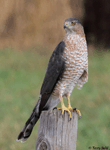 |
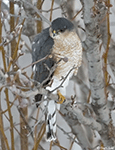 |
| Red-shouldered Hawk | Red-tailed Hawk | Cooper's Hawk | Sharp-shinned Hawk |
Conservation Status:
Broad-winged Hawks are found across a broad geographic range, and are common in parts of that range. Recent systematic surveys such as the Breeding Bird Survey show increases in population over the last few decades. The IUCN considers the Broad-winged Hawk to be a species of "Least Concern".
South Dakota "Hotspot":
Very small numbers breed in the far eastern part of the state, but they are most commonly found during migration. They prefer forested areas are often found perched in a tree on the edge of a forest clearing. Forest habitat in general isn't exactly widespread in South Dakota, so the best places to look for them in migration are in the heavily wooded parks and riparian areas along the eastern edge of the state, including the Big Sioux Recreation Area, Newton Hills State Park, Beaver Creek Nature Area, and North Alabama Bend.
Further Information:
- University of Minnesota Raptor Center - Broad-winged Hawk
- WhatBird - Broad-winged Hawk
- Audubon Guide - Broad-winged Hawk
Photo Information:
Photo by Terry Sohl - May 4th, 2015 - Big Sioux Recreation Area near Brandon, South Dakota.
Audio File Credits:
- 1Alex MacPhail. Recorded in Alberta on July 6th, 2015. Original recording and information available from xeno-canto.
- 2Niels Krabbe. Recorded in Ecuador on January 8th, 1994. Original recording and information available from xeno-canto.
| Click on the range map for a higher-resolution view |
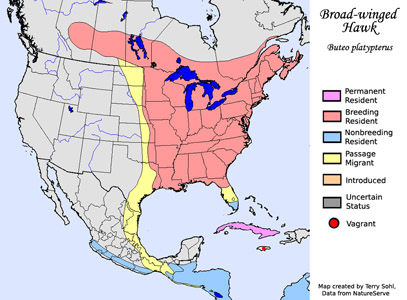 |
| South Dakota Status: Common migrant in the northeast part of the state, uncommon elsewhere. Rare to uncommon summer resident in the Black Hills, and the extreme northeastern and southeastern corners of the state. |
